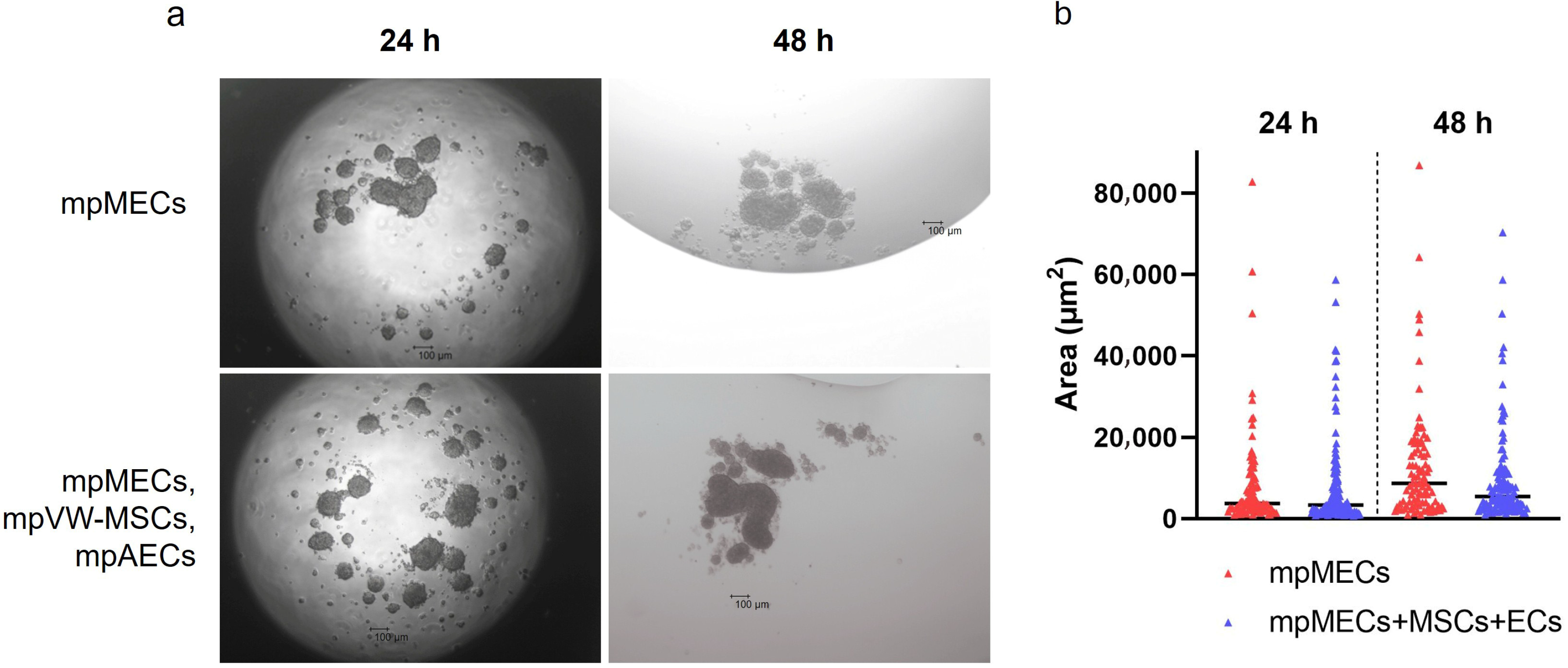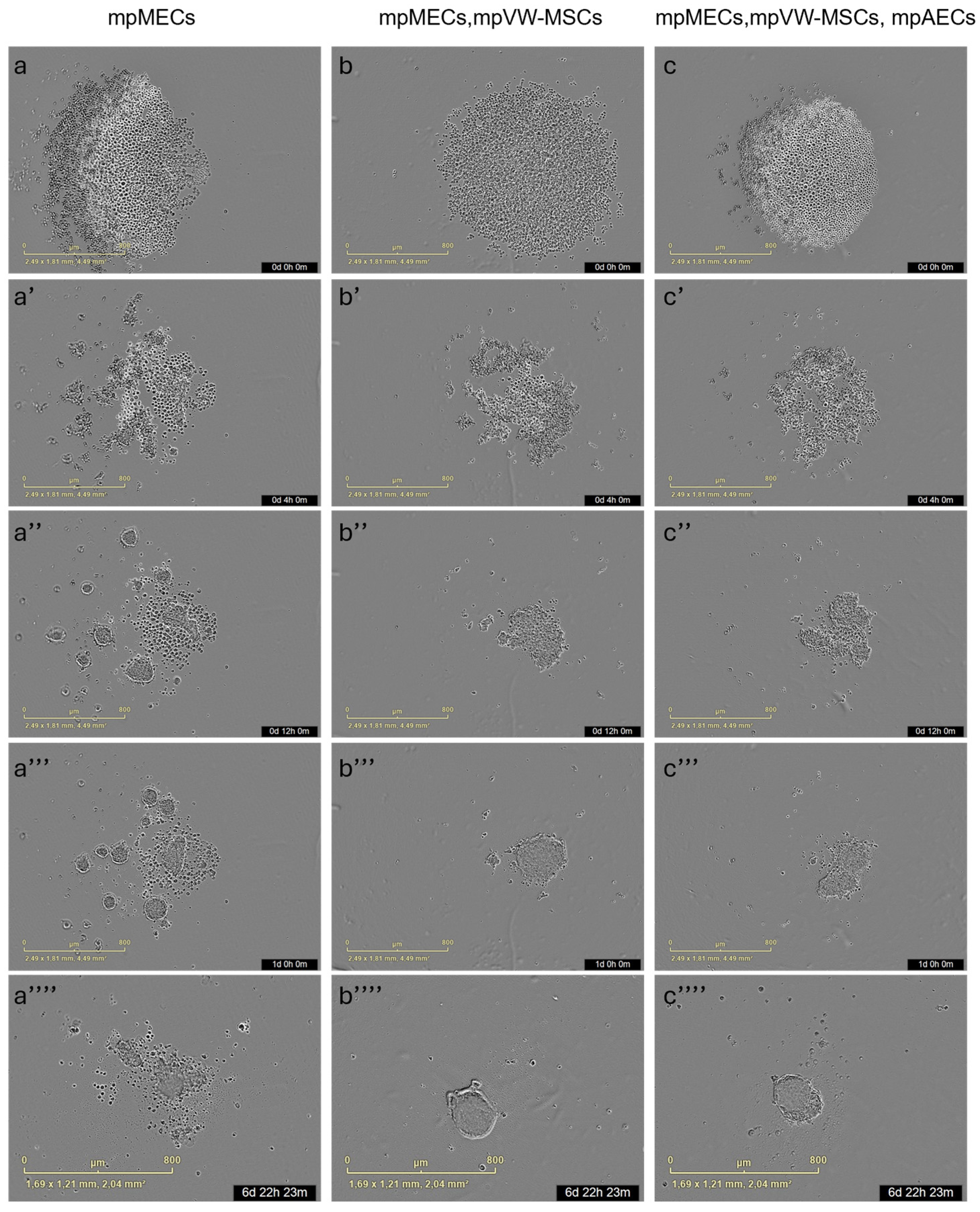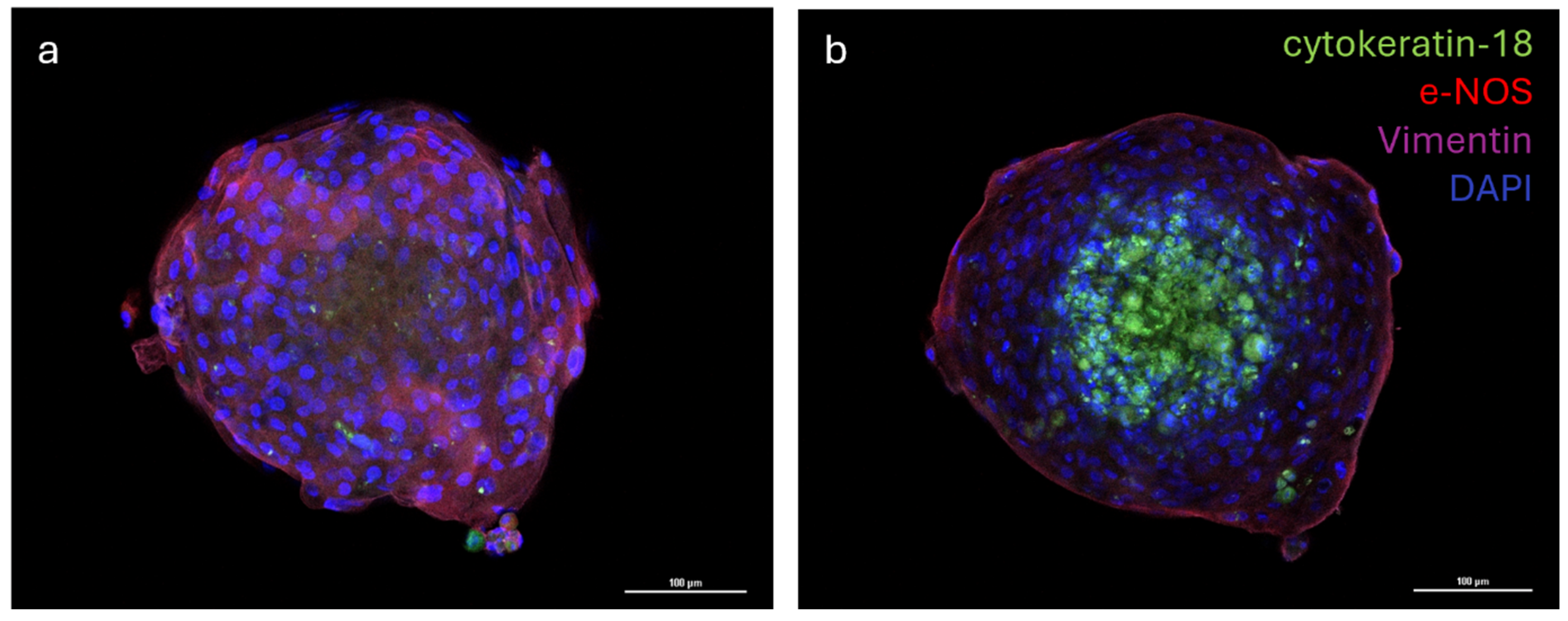Mammary Epithelial Cell Spheroid: Stabilization Through Vascular-Wall Mesenchymal Stem Cells and Endothelial Cells Co-Culture
Simple Summary
Abstract
1. Introduction
2. Materials and Methods
2.1. Chemicals and Reagents
2.2. Culture of mpMECs, mpAECs, and mpVW-MSCs
2.3. Three-Dimensional Culture by Hanging-Drop Assay
2.4. Three-Dimensional Culture in Low-Adherent Plate and Long-Term Culture
2.5. Viability Assay
2.6. Immunofluorescence Analysis
2.7. Statistical Analysis
3. Results
3.1. Cell Morphology and Formation of Cellular 3D Aggregates via Hanging-Drop Method
3.2. Culture in Low Adherence Round-Bottom Plates and Spheroid Formation
3.3. Spheroid Viability
3.4. Cellular Distribution of the mpVW-MSCs, mpAECs, and mpMECs on Multicellular Spheroid
4. Discussion
5. Conclusions
Author Contributions
Funding
Institutional Review Board Statement
Informed Consent Statement
Data Availability Statement
Acknowledgments
Conflicts of Interest
References
- Maldonado, V.V.; Patel, N.H.; Smith, E.E.; Barnes, C.L.; Gustafson, M.P.; Rao, R.R.; Samsonraj, R.M. Clinical Utility of Mesenchymal Stem/Stromal Cells in Regenerative Medicine and Cellular Therapy. J. Biol. Eng. 2023, 17, 44. [Google Scholar] [CrossRef]
- Margiana, R.; Markov, A.; Zekiy, A.O.; Hamza, M.U.; Al-Dabbagh, K.A.; Al-Zubaidi, S.H.; Hameed, N.M.; Ahmad, I.; Sivaraman, R.; Kzar, H.H.; et al. Clinical Application of Mesenchymal Stem Cell in Regenerative Medicine: A Narrative Review. Stem Cell Res. Ther. 2022, 13, 366. [Google Scholar] [CrossRef] [PubMed]
- Wu, X.; Jiang, J.; Gu, Z.; Zhang, J.; Chen, Y.; Liu, X. Mesenchymal Stromal Cell Therapies: Immunomodulatory Properties and Clinical Progress. Stem Cell Res. Ther. 2020, 11, 345. [Google Scholar] [CrossRef]
- Hoseinzadeh, A.; Esmaeili, S.-A.; Sahebi, R.; Melak, A.M.; Mahmoudi, M.; Hasannia, M.; Baharlou, R. Fate and Long-Lasting Therapeutic Effects of Mesenchymal Stromal/Stem-like Cells: Mechanistic Insights. Stem Cell Res. Ther. 2025, 16, 33. [Google Scholar] [CrossRef] [PubMed]
- Klein, D. Vascular Wall-Resident Multipotent Stem Cells of Mesenchymal Nature within the Process of Vascular Remodeling: Cellular Basis, Clinical Relevance, and Implications for Stem Cell Therapy. Stem Cells Int. 2016, 2016, 1905846. [Google Scholar] [CrossRef]
- Dangat, K.; Khaire, A.; Joshi, S. Cross Talk of Vascular Endothelial Growth Factor and Neurotrophins in Mammary Gland Development. Growth Factors 2020, 38, 16–24. [Google Scholar] [CrossRef]
- Bautch, V.L. Stem Cells and the Vasculature. Nat. Med. 2011, 17, 1437–1443. [Google Scholar] [CrossRef]
- Tang, Z.; Wang, A.; Yuan, F.; Yan, Z.; Liu, B.; Chu, J.S.; Helms, J.A.; Li, S. Differentiation of Multipotent Vascular Stem Cells Contributes to Vascular Diseases. Nat. Commun. 2012, 3, 875. [Google Scholar] [CrossRef]
- Psaltis, P.J.; Simari, R.D. Vascular Wall Progenitor Cells in Health and Disease. Circ. Res. 2015, 116, 1392–1412. [Google Scholar] [CrossRef]
- Invernici, G.; Emanueli, C.; Madeddu, P.; Cristini, S.; Gadau, S.; Benetti, A.; Ciusani, E.; Stassi, G.; Siragusa, M.; Nicosia, R.; et al. Human Fetal Aorta Contains Vascular Progenitor Cells Capable of Inducing Vasculogenesis, Angiogenesis, and Myogenesis in Vitro and in a Murine Model of Peripheral Ischemia. Am. J. Pathol. 2007, 170, 1879–1892. [Google Scholar] [CrossRef]
- Pasquinelli, G.; Tazzari, P.L.; Vaselli, C.; Foroni, L.; Buzzi, M.; Storci, G.; Alviano, F.; Ricci, F.; Bonafè, M.; Orrico, C.; et al. Thoracic Aortas from Multiorgan Donors Are Suitable for Obtaining Resident Angiogenic Mesenchymal Stromal Cells. Stem Cells 2007, 25, 1627–1634. [Google Scholar] [CrossRef]
- da Silva Meirelles, L.; Chagastelles, P.C.; Nardi, N.B. Mesenchymal Stem Cells Reside in Virtually All Post-Natal Organs and Tissues. J. Cell Sci. 2006, 119, 2204–2213. [Google Scholar] [CrossRef]
- Howson, K.M.; Aplin, A.C.; Gelati, M.; Alessandri, G.; Parati, E.A.; Nicosia, R.F. The Postnatal Rat Aorta Contains Pericyte Progenitor Cells That Form Spheroidal Colonies in Suspension Culture. Am. J. Physiol. Cell Physiol. 2005, 289, C1396–C1407. [Google Scholar] [CrossRef]
- Zaniboni, A.; Bernardini, C.; Alessandri, M.; Mangano, C.; Zannoni, A.; Bianchi, F.; Sarli, G.; Calzà, L.; Bacci, M.L.; Forni, M. Cells Derived from Porcine Aorta Tunica Media Show Mesenchymal Stromal-like Cell Properties in in Vitro Culture. Am. J. Physiol. Cell Physiol. 2014, 306, C322–C333. [Google Scholar] [CrossRef] [PubMed][Green Version]
- Zaniboni, A.; Bernardini, C.; Bertocchi, M.; Zannoni, A.; Bianchi, F.; Avallone, G.; Mangano, C.; Sarli, G.; Calzà, L.; Bacci, M.L.; et al. In Vitro Differentiation of Porcine Aortic Vascular Precursor Cells to Endothelial and Vascular Smooth Muscle Cells. Am. J. Physiol. Cell Physiol. 2015, 309, C320–C331. [Google Scholar] [CrossRef] [PubMed][Green Version]
- Luu, N.T.; McGettrick, H.M.; Buckley, C.D.; Newsome, P.N.; Rainger, G.E.; Frampton, J.; Nash, G.B. Crosstalk between Mesenchymal Stem Cells and Endothelial Cells Leads to Downregulation of Cytokine-Induced Leukocyte Recruitment. Stem Cells 2013, 31, 2690–2702. [Google Scholar] [CrossRef] [PubMed]
- Vorwald, C.E.; Joshee, S.; Leach, J.K. Spatial Localization of Endothelial Cells in Heterotypic Spheroids Influences Notch Signaling. J. Mol. Med. 2020, 98, 425–435. [Google Scholar] [CrossRef]
- Meng, X.; Chen, M.; Su, W.; Tao, X.; Sun, M.; Zou, X.; Ying, R.; Wei, W.; Wang, B. The Differentiation of Mesenchymal Stem Cells to Vascular Cells Regulated by the HMGB1/RAGE Axis: Its Application in Cell Therapy for Transplant Arteriosclerosis. Stem Cell Res. Ther. 2018, 9, 85. [Google Scholar] [CrossRef]
- Bernardini, C.; Bertocchi, M.; Zannoni, A.; Salaroli, R.; Tubon, I.; Dothel, G.; Fernandez, M.; Bacci, M.L.; Calzà, L.; Forni, M. Constitutive and LPS-Stimulated Secretome of Porcine Vascular Wall-Mesenchymal Stem Cells Exerts Effects on in Vitro Endothelial Angiogenesis. BMC Vet. Res. 2019, 15, 123. [Google Scholar] [CrossRef]
- Lin, R.; Wang, S.; Zhao, R.C. Exosomes from Human Adipose-Derived Mesenchymal Stem Cells Promote Migration through Wnt Signaling Pathway in a Breast Cancer Cell Model. Mol. Cell. Biochem. 2013, 383, 13–20. [Google Scholar] [CrossRef]
- Klopp, A.H.; Lacerda, L.; Gupta, A.; Debeb, B.G.; Solley, T.; Li, L.; Spaeth, E.; Xu, W.; Zhang, X.; Lewis, M.T.; et al. Mesenchymal Stem Cells Promote Mammosphere Formation and Decrease E-Cadherin in Normal and Malignant Breast Cells. PLoS ONE 2010, 5, e12180. [Google Scholar] [CrossRef] [PubMed]
- McManaman, J.L.; Neville, M.C. Mammary Physiology and Milk Secretion. Adv. Drug Deliv. Rev. 2003, 55, 629–641. [Google Scholar] [CrossRef] [PubMed]
- Kobayashi, K. Culture Models to Investigate Mechanisms of Milk Production and Blood-Milk Barrier in Mammary Epithelial Cells: A Review and a Protocol. J. Mammary Gland. Biol. Neoplasia 2023, 28, 8. [Google Scholar] [CrossRef] [PubMed]
- Kobayashi, K.; Oyama, S.; Numata, A.; Rahman, M.M.; Kumura, H. Lipopolysaccharide Disrupts the Milk-Blood Barrier by Modulating Claudins in Mammary Alveolar Tight Junctions. PLoS ONE 2013, 8, e62187. [Google Scholar] [CrossRef]
- Finot, L.; Chanat, E.; Dessauge, F. Mammary Gland 3D Cell Culture Systems in Farm Animals. Vet. Res. 2021, 52, 78. [Google Scholar] [CrossRef]
- Arévalo Turrubiarte, M.; Perruchot, M.-H.; Finot, L.; Mayeur, F.; Dessauge, F. Phenotypic and Functional Characterization of Two Bovine Mammary Epithelial Cell Lines in 2D and 3D Models. Am. J. Physiol. Cell Physiol. 2016, 310, C348–C356. [Google Scholar] [CrossRef][Green Version]
- Ogorevc, J.; Zorc, M.; Dovč, P. Development of an In Vitro Goat Mammary Gland Model: Establishment, Characterization, and Applications of Primary Goat Mammary Cell Cultures. In Goat Science; Kukovics, S., Ed.; InTech: Houston, TX, USA, 2018; ISBN 978-1-78923-202-8. [Google Scholar][Green Version]
- Bernardini, C.; La Mantia, D.; Salaroli, R.; Zannoni, A.; Nauwelaerts, N.; Deferm, N.; Ventrella, D.; Bacci, M.L.; Sarli, G.; Bouisset, M.; et al. Development of a Pig Mammary Epithelial Cell Culture Model as a Non-Clinical Tool for Studying Epithelial Barrier—A Contribution from the IMI-ConcePTION Project. Animal 2021, 11, 2012. [Google Scholar] [CrossRef]
- Bernardini, C.; Nesci, S.; La Mantia, D.; Salaroli, R.; Nauwelaerts, N.; Ventrella, D.; Elmi, A.; Trombetti, F.; Zannoni, A.; Forni, M. Isolation and Characterization of Mammary Epithelial Cells Derived from Göttingen Minipigs: A Comparative Study versus Hybrid Pig Cells from the IMI-ConcePTION Project. Res. Vet. Sci. 2024, 172, 105244. [Google Scholar] [CrossRef]
- La Mantia, D.; Nauwelaerts, N.; Bernardini, C.; Zannoni, A.; Salaroli, R.; Lin, Q.; Huys, I.; Annaert, P.; Forni, M. Development and Characterization of a Human Mammary Epithelial Cell Culture Model for the Blood–Milk Barrier—A Contribution from the ConcePTION Project. Int. J. Mol. Sci. 2024, 25, 11454. [Google Scholar] [CrossRef]
- Bernardini, C.; La Mantia, D.; Salaroli, R.; Ventrella, D.; Elmi, A.; Zannoni, A.; Forni, M. Isolation of Vascular Wall Mesenchymal Stem Cells from the Thoracic Aorta of Adult Göttingen Minipigs: A New Protocol for the Simultaneous Endothelial Cell Collection. Animals 2023, 13, 2601. [Google Scholar] [CrossRef]
- Paris, F.; Marrazzo, P.; Pizzuti, V.; Marchionni, C.; Rossi, M.; Michelotti, M.; Petrovic, B.; Ciani, E.; Simonazzi, G.; Pession, A.; et al. Characterization of Perinatal Stem Cell Spheroids for the Development of Cell Therapy Strategy. Bioengineering 2023, 10, 189. [Google Scholar] [CrossRef]
- Piccinini, F.; Tesei, A.; Arienti, C.; Bevilacqua, A. Cancer Multicellular Spheroids: Volume Assessment from a Single 2D Projection. Comput. Methods Programs Biomed. 2015, 118, 95–106. [Google Scholar] [CrossRef]
- Kozlowski, M.; Gajewska, M.; Majewska, A.; Jank, M.; Motyl, T. Differences in Growth and Transcriptomic Profile of Bovine Mammary Epithelial Monolayer and Three-Dimensional Cell Cultures. J. Physiol. Pharmacol. 2009, 60 (Suppl. 1), 5–14. [Google Scholar]
- Sun, Y.L.; Lin, C.S.; Chou, Y.C. Establishment and Characterization of a Spontaneously Immortalized Porcine Mammary Epithelial Cell Line. Cell Biol. Int. 2006, 30, 970–976. [Google Scholar] [CrossRef] [PubMed]
- Darcy, K.M.; Zangani, D.; Lee, P.-P.H.; Ip, M.M. Isolation and Culture of Normal Rat Mammary Epithelial Cells. In Methods in Mammary Gland Biology and Breast Cancer Research; Ip, M.M., Asch, B.B., Eds.; Springer: Boston, MA, USA, 2000; pp. 163–175. ISBN 978-1-4615-4295-7. [Google Scholar]
- Shekhar, M.P.; Werdell, J.; Tait, L. Interaction with Endothelial Cells Is a Prerequisite for Branching Ductal-Alveolar Morphogenesis and Hyperplasia of Preneoplastic Human Breast Epithelial Cells: Regulation by Estrogen. Cancer Res. 2000, 60, 439–449. [Google Scholar] [PubMed]
- Proia, D.A.; Kuperwasser, C. Reconstruction of Human Mammary Tissues in a Mouse Model. Nat. Protoc. 2006, 1, 206–214. [Google Scholar] [CrossRef] [PubMed]
- Wang, X.; Kaplan, D.L. Hormone-Responsive 3D Multicellular Culture Model of Human Breast Tissue. Biomaterials 2012, 33, 3411–3420. [Google Scholar] [CrossRef]
- Ortiz, E.; Thway, K.H.; Ortiz-Soto, G.; Yao, P.; Kelber, J.A. Heteromulticellular Stromal Cells in Scaffold-Free 3D Cultures of Epithelial Cancer Cells to Drive Invasion. J. Vis. Exp. 2025, e67902. [Google Scholar] [CrossRef]
- Masedunskas, A.; Weigert, R.; Mather, I. Intravital Imaging of the Lactating Mammary Gland in Transgenic Mice Expressing Fluorescent Proteins; Springer: Berlin/Heidelberg, Germany, 2014; pp. 187–204. ISBN 978-94-017-9360-5. [Google Scholar]






| Antibody | P. Number | Species | Supplier | Dilution |
|---|---|---|---|---|
| Primary | ||||
| eNOS | SA-258 | mouse | BIOMOL Research Laboratories | 1:100 |
| FITC cytokeratin-18 | ab52459 | mouse | Abcam | 5 µg/mL |
| Alexa-Fluor 647 vimentin | ab194719 | mouse | Abcam | 1:800 |
| Secondary | ||||
| Rhodamine Red-X anti-mouse | AB_2340832 | donkey | Jackson ImmunoResearch | 1:800 |
Disclaimer/Publisher’s Note: The statements, opinions and data contained in all publications are solely those of the individual author(s) and contributor(s) and not of MDPI and/or the editor(s). MDPI and/or the editor(s) disclaim responsibility for any injury to people or property resulting from any ideas, methods, instructions or products referred to in the content. |
© 2025 by the authors. Licensee MDPI, Basel, Switzerland. This article is an open access article distributed under the terms and conditions of the Creative Commons Attribution (CC BY) license (https://creativecommons.org/licenses/by/4.0/).
Share and Cite
La Mantia, D.; Salaroli, R.; Petrovic, B.; Ventrella, D.; Zannoni, A.; Forni, M.; Bernardini, C. Mammary Epithelial Cell Spheroid: Stabilization Through Vascular-Wall Mesenchymal Stem Cells and Endothelial Cells Co-Culture. Animals 2025, 15, 3095. https://doi.org/10.3390/ani15213095
La Mantia D, Salaroli R, Petrovic B, Ventrella D, Zannoni A, Forni M, Bernardini C. Mammary Epithelial Cell Spheroid: Stabilization Through Vascular-Wall Mesenchymal Stem Cells and Endothelial Cells Co-Culture. Animals. 2025; 15(21):3095. https://doi.org/10.3390/ani15213095
Chicago/Turabian StyleLa Mantia, Debora, Roberta Salaroli, Biljana Petrovic, Domenico Ventrella, Augusta Zannoni, Monica Forni, and Chiara Bernardini. 2025. "Mammary Epithelial Cell Spheroid: Stabilization Through Vascular-Wall Mesenchymal Stem Cells and Endothelial Cells Co-Culture" Animals 15, no. 21: 3095. https://doi.org/10.3390/ani15213095
APA StyleLa Mantia, D., Salaroli, R., Petrovic, B., Ventrella, D., Zannoni, A., Forni, M., & Bernardini, C. (2025). Mammary Epithelial Cell Spheroid: Stabilization Through Vascular-Wall Mesenchymal Stem Cells and Endothelial Cells Co-Culture. Animals, 15(21), 3095. https://doi.org/10.3390/ani15213095







